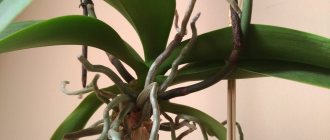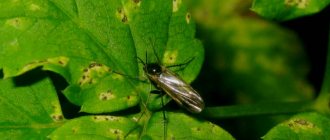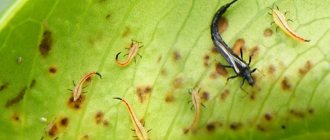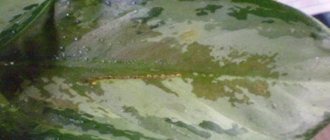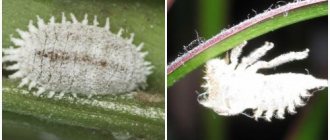Despite the fact that the number of root mites is much smaller than that of spider mites, aphids, and scale insects, they cause serious damage to plants. These pests are very smart and cunning. Carefully hiding in the ground and hiding their lair, they eat plant roots. Soil mites pose a danger to indoor and bulbous plants. Most of all they love to feast on orchids, lilies, daffodils, hyacinths and tulips. The parasites begin to gnaw the bulb from below. Climbing between the scales, they infect the diseased tissues of the bulbs, and then proceed to the healthy ones. The plant stops blooming and bearing fruit and dries out. When a bulb is damaged by a soil mite, it becomes covered with brown dust.
A root mite is a small spider. It has three pairs of legs, sharp antennae, and a large light transparent oval body. The parasite is very hardy. Can live for a long time without moisture and food. It feeds on underground parts of plants and organic remains. Lives in tops and fallen leaves.
Description of the pest
Onion root mite is one of the main types of parasites that damage the underground parts of the plant. It is easy to recognize by its appearance: it is translucent, with a shiny surface, milky or yellowish in color.
He is very hardy, and without food and moisture he does not die, his life processes just slow down. But when the temperature rises to +20 °C and the humidity rises, they come to life again and begin to actively feed on roots and bulbs.
Root mites have strong jaws, so they very easily and quickly eat bulb tissue , where in the freed space, females lay large clutches of eggs. Gloxinia, hyacinths and orchids are more susceptible to infection than others.
The role of soil mites in nature
Soil is a complex of living and nonliving components that are present in various combinations. Small arthropods, including several groups of mites, contribute to the solidification of the humus fraction and also allow the existence of soil organisms.
Even though mites play a role in soil mixing, it may be small compared to larger invertebrates such as earthworms, insects, crustaceans and centipedes. But at the same time, mites perform an important function in mineral turnover, which allows vegetation to grow, and also participate as destroyers of organic matter.
Soil mites organize a density of 50,000-250,000 units per square meter, which can be found in the upper layers of the soil. Dozens of species can be found in a small area when the soil is rich in organic material such as decaying vegetation, excrement or animal remains. In combination with the microflora on which ticks feed, many of their species help in the decomposition of organic matter that they are able to digest. Thus, soil mites play, if not the main, then an irreplaceable role in the formation of an ecosystem of fertile humus.
Types of mites that live in soil
Ticks are the largest group of arachnids. 54 thousand species have been described, most of which live in the upper layers of the soil. These animals have microscopic sizes ranging from 0.2 mm to 1 mm. Their body is solid, there are 6 pairs of appendages. The anterior pairs transformed into oral organs - chelicerae and pedipalps. The remaining 4 pairs are legs.
Based on the nature of their diet, they are divided into several groups:
- saprophages - species that feed on organic remains of plant and animal origin;
- phytophages – arthropods that eat plant tissue;
- predators - mites that prey on small insects, invertebrates, nematodes, etc.
Oribatid mites (Oribatida) are the dominant species among soil inhabitants. They go through 5 phases in their development. At the adult stage, they are resistant to various external influences due to the presence of a hard shell. Living and dead plants, mushrooms, and lichens are used as food. There are no parasites among oribatid mites.
Information. The number of Oribatida in the soil reaches 100 thousand individuals per 1 square meter. m.
In addition to oribatids, hundreds of species of mites live in the soil, helping to process organic residues. Their life activity is closely related to microflora. Soil mites eat bacteria, fungal spores, and algae. Their population increases in spring and autumn, when the ground is abundantly moist. During the dry summer period, the arthropod population declines.
The neighbors of saprophagous mites are predators. These individuals are larger in size than their herbivorous relatives. Representatives of the family Bdellidae reach 3.5 mm. These are free-living individuals with a soft body and a growth on the head in the form of an elongated nose. Its diet includes small arthropods and insect larvae.
Signs of infection
Root mites harm a variety of plants, primarily by damaging their underground organs. Most often they settle on garlic and onions. Among ornamental plants, they most often infect daffodils, tulips, orchids, gladioli, dahlias and hyacinths. But root mites in indoor flowers are still relatively rare. Plants are harmed not only by adult mites, but also by their larvae.
The leaves undergo deformation - they may warp, and areas different from the main color of the leaves begin to appear on them. The plant stops growing, its peduncle primordia are deformed.
Important! Diseases caused by root mites may be caused by pots in which the soil has not been changed for a long time or the drainage does not function properly.
Damaged bulbs begin to mold and rot. If the bulb has been affected by root mites for a long time, it begins to shrink and loses its elasticity due to dehydration. In the later stages of the lesion, the bulb crumbles into brown dust, and the bottom falls off. Larval skins and excrement of mites can be found in the dust; mites themselves are often found at all stages of development.
How to deal with soil mites?
If the substrate is heavily infested with mites, it should be immediately replaced with a fresh one, and the roots of the plant should be thoroughly disinfected. Tansy decoction is ideal for this , which is very easy and simple to prepare. Take 100 g of dry herb and brew it for about 15 minutes in 1 liter of boiling water. Allow the broth to cool and dip the roots or bulbs into it for 30 minutes.
To limit the number of ticks, you need to regulate the moisture in the soil. To do this, you need to stop watering for 7-10 days, and create a good drainage layer at the bottom of the pot, which will regulate the amount of moisture received by the roots.
If a soil plant is seriously infested with mites, one should resort to more serious methods of control, such as chemicals:
- Akarin. A biological agent that has an intestinal contact effect.
- Apollo. A concentrated suspension that has a contact effect on parasites. The rate of its use is always the same - take 2 ml. for 5 l. water.
- Vertimek. A natural preparation created on the basis of a mushroom.
- Mites. An insectoacaricidal drug that is best suited for protecting ornamental plants in closed ground. The effect of this remedy is observed already on the 3rd day after treating the diseased flower.
- Envidor. The drug adheres to the leaves of the diseased plant and prevents further reproduction of pests. Already on the 15th day the flower can be completely healthy.
- Nissan. Effectively kills males, but does not have a detrimental effect on females. In this case, the vital activity of the eggs stops, due to this, the mites die out after a few days.
- Nurrell-D. Copes with all types of ticks at various larval stages. Also fights adult parasites.
- Sunmite. The active effect of the drug will allow you to neutralize the plant after 15 minutes of use. Plants should be sprayed with a diluted solution, and the soil should be sprinkled with powder.
- Flumite. It has a sterilizing effect, due to which females lay non-viable eggs.
- Omite 30 and Omite 57. Effectively destroy most phytophagous mites. They affect the active stages of arachnid development through direct contact or in pairs during evaporation. They do not affect the eggs, but the residual effect of the drug kills the larvae.
- Borneo. They destroy the eggs and larvae of arthropods, do not kill adults, but sterilize the females, thereby reducing the pest population.
In the fight against soil mites, it is quite effective to use traditional methods:
- Soaking the roots of a diseased plant in tansy tincture. The herb can be used both fresh and dried. If freshly picked tansy is used, then you need to take 150 g, if dry, then 25 g. The raw materials are poured into 0.5 liters. hot water and leave for about 20 minutes, then dilute with clean water in a 1:1 ratio. For best results, cleaned tubers and plant roots should be kept in this solution for about 15 - 30 minutes.
- As a spray, you can use a tincture based on wood ash. To do this, infuse 1 tbsp for about a day. ash in 5 l. water. It is also good to add 50 g of crushed laundry soap to this mixture.
- Infusion of alder leaves. In 1 l. boiling water for 36 hours, infuse a tablespoon of finely chopped herbs. The roots of the plant are kept in the infusion at 45 degrees. Do not leave naked bulbs in this healing mixture for more than 8 minutes.
- Spraying with garlic infusion. 2 medium heads of garlic should be placed in a container with 1 liter. boiling water Close tightly and leave for about 5 days in a dark place. Before spraying, dilute the solution 1:1 with clean running water.
Preventive measures against infection
Reference! To avoid infestation of potted plants with root or soil mites, they should be provided with good drainage. Do not over-water flowers, especially in humid indoor climates. You should try to keep the pallets dry; stagnation of water in them is completely eliminated.
Planting material should be stored properly to avoid the appearance of parasites in it. To do this, select sealed packages and place them in a dark and comfortable room in terms of humidity. For planting, you should choose shaded places and control the level of humidity in the room and in the soil.
When root mites appear in indoor plants, immediate measures should be taken to destroy them. The faster preventative work is carried out, the less chance neighboring indoor flowers will have of becoming infected. To prevent soil contamination, you need to control the soil moisture and monitor the drainage of the pot component.
Signs of plant damage
Under normal natural conditions, root mites are found in the soil. The appearance of animals on the ground surface indicates rapid reproduction and exceeding the permissible safe norm. Characteristic signs of damage include:
- the presence around the rhizome of multiple passages (grooves) filled with crushed white dust;
- wrinkled, dried out and loose bulbs covered with mold and spots;
- rotten or rotten tubers that are easily mashed or crumble in your hands;
- deformation of peduncle primordia, growth retardation;
- putrid smell of soil;
- dark areas and small holes on the leaves in the form of punctures with a needle;
- the presence of shells from larvae in the soil mixture;
- brown scar tissue on the undersides of leaves.
It is impossible to see small pests in a pot with the naked eye. To verify their presence, you can use a magnifying glass.
The main reason for the proliferation of mites is excess moisture and undecomposed organic matter. Heavily affected crops are removed along with the soil; for weakened ones, a set of measures is carried out to improve the health and destroy pests:
- restoring soil balance, cleaning and filtering the earth (reducing moisture, nutrients and the number of protozoa);
- plant transplantation;
- reducing the diameter of the wick;
- reducing indoor air humidity;
- treatment with acaricides and insecticides.
If the soil is heavily infested with soil parasites, it is recommended to replace it with a new one. Before planting a plant in a new substrate, its roots must be disinfected. You can use tansy decoction for this. Boil 100 g of herb in a liter of water for about 10 minutes, then cool and keep the plant bulbs in the prepared liquid for 20-30 minutes.
Another effective method that will help significantly reduce the number of ticks is lowering the soil moisture. To do this, indoor flowers are not watered for at least a week. At the bottom of the flowerpot you need to make a drainage layer, with the help of which the humidity is controlled.
Soil mites are hardy. If the conditions for their life worsen, then these arthropods enter diapause - a state similar to suspended animation.
Causes of infection
Ticks live well in warm and moist (even completely liquefied) substrate. Therefore, constant excessive waterlogging of the soil can cause their appearance.
They are also easily transmitted from one infected plant to another. Therefore, infected plants are destroyed or isolated from healthy ones, or immediately treated, while simultaneously carrying out prophylaxis among healthy plants.
The easiest way to infect plants with mites is to purchase bulbs or substrate from the store that already contain the parasite.
In case of severe damage
How to deal with soil mites if the number of affected areas is already large? Folk remedies can no longer cope; more intensive measures must be used. Treatment with systemic insecticides will help destroy all parasites. Moreover, this remedy acts for a long time, so it manages to destroy even the future generation. Actellik or Neoron are best suited. Do not forget that insects get used to the drugs used, and therefore they should be alternated. Typically, systemic insecticides can save the plant even in the most advanced cases. And only if the bulb begins to rot due to a large amount of damage, it becomes impossible to save it.
Pest prevention
To prevent the appearance of mites, it is necessary to properly handle the bulbs and planting material.
- Do not buy seed, seedlings and flowers if they make you suspicious. Mites most often hide under the first two sheets of onion scales; they are easy to see if you move the scales apart a little. If you cannot check the bulb for mites, it is better to refuse the purchase.
- Own plant material is dried before planting. Onion sets are kept at a temperature of +40°C for 16 hours, after which they are planted in the soil. Seed material for indoor plants is treated with acaricides.
- It is recommended to water the planted plants from time to time with water at a temperature of about +35°C. Such water will be fatal to parasites. During the period of active growth, plants can be sprayed with infusions of tomato tops or chamomile.
On a note! Biological methods are also used to destroy root pests. Hypoaspis mites will happily feed not only on root mites, but also on thrips, regulating the pest population.
Before storing, you need to thoroughly dry both the storage and the bulbs. It is recommended to etch the storage facility with sulfur dioxide. The bulbs are treated with agents against fungi and mites.
Temperature and humidity in storage facilities are reduced. The plant material is powdered with chalk and colloidal sulfur. It is necessary to regularly inspect storage facilities in order to promptly find moldy areas and remove them.
Prevention of root mites
The best method of preventing root mites is to maintain clean topsoil and an optimal environment for plants. You should not leave wilted flowers on the peduncles, and even more so, do not allow fallen leaves to lie, or allow debris to accumulate on top of the substrate (the contaminated top layer can be removed more often, and not only during replanting or in the spring).
Air humidity must be maintained within optimal limits. And wiping leaves or showering for those plants that allow this should not be accompanied by soaking and contamination of the soil. You should always try to maintain the required substrate humidity. Overmoistening, dampness, and stagnation of water in trays are extremely dangerous for all bulbous plants.
Signs of damage to the bulb by root mites. © Doctor Mom
Proper storage of bulbs during the dormant stage is equally important. A cool, dry room with a humidity level of no higher than 40% is the main guarantee that the bulbs, both outside the soil and in pots that are in the dormant phase, will not suffer from these pests.
If you are just purchasing bulbs for planting, it is better to leave them for several days in a cool, dry place and inspect them carefully. But no one is safe from purchasing infected blooming beauties. Therefore, the quarantine period is very important and should be strictly observed.
How to get rid of pests
If the lesion is minor, and you noticed it on time, then no problems with treatment should arise, especially if you know how to get rid of soil mites.
- The easiest way is a soap solution. They water the ground with it and wipe the leaves.
- The second most popular, but not most effective, is an infusion of garlic in water. Usually the procedures are repeated until all symptoms of the disease disappear completely.
- For indoor plants, you can use an ultraviolet lamp. It is enough to keep it on for two minutes a couple of times a week, and all pests will completely disappear.
- Nettle also helps fight pests. To do this, take 0.7 kg of nettle and pour 5 liters of boiling water. Place the vessel in a warm place. After five days, strain, dilute 1:10 and water at the root.
Structure and shape
Representatives of soil mites - putrefactive and bulbous mites - that are similar in morphological characteristics can be examined in more detail using the example of the second. Its influence on the fruits of human labor in the field of agriculture and gardening obliges us to know the enemy by sight.
Both of these species are polyphagous, that is, they are not particularly picky about food; in other words, they eat everything, from the rough roots of cereals to the delicate bulbs of chrysanthemums. They also do not disdain the root crops of onions, carrots, beets and potatoes, which is why they have earned a sad reputation among gardeners.
In addition to their natural home - earthen soil, these creatures also spread into vegetable stores, cellars and barns.
The means of delivery there are the same plants and fruits that they ate in the wild, and now they will continue to eat them in storage areas, significantly reducing the shelf life of vegetables and cereals.
In their structure, these creatures are similar to the entire family of acarids:
- An adult individual, imago, has an oval, wide and tapering body of a light yellow color, covered with a soft chitinous shield at the base. Short, thick limbs are armed with spines and covered, like the whole body, with bristles.
- Females are 2–3 tenths of a millimeter longer than males and reach just over 1 mm.
- The nymph is the next phase of the development of the soil mite after the larva, exceeding that in size, but inferior to the imago, also having four pairs of legs.
- Larvae are embryos hatched from eggs with three more pairs of legs.
- The egg of the bulb mite is usually white, has a characteristic shape and is relatively large in size.
Another, separate, phase of the nymph, during which the creature experiences unfavorable climatic and other conditions for further development, is called hypopus. At this stage, all vital processes slow down as much as possible, which helps to tolerate temperature and humidity parameters that are critical for the normal state of the individual.
Interesting to know
“The change of phases occurs through the so-called molting, when the old chitinous shell is shed, which indicates favorable growth conditions”
Common types
The numerous species of arthropods living under the surface of the earth imply their classification and division into groups, depending on their numbers, prevalence, feeding method and degree of influence on human life. The latter circumstance distinguishes two groups of soil mites:
- Tirophagus - acarid mite, called putrefactive, elongated;
- Rhizoglyphus echinopus is a bulbous root plant, also from the order Acariformes.
A change in composition towards moisture and an increase in soil temperature, as the habitat of these arthropods, leads to an active increase in their population. During such periods, the natural ecological balance is disrupted, and soil mites, instead of having a beneficial effect on the interaction between soil and plants, become pests.
Feeding on rotting plant remains and other decaying organic matter, they affect the mineral value of the soil. However, the matter is not limited to eating dead plants and root mites, as they are also called, do not disdain the bulbs of living plants and flowers.
Their microscopic size – up to 0.5 mm – does not play a negative role in the development of the owner of tasty root vegetables and roots, as long as the number of individuals does not translate into the quality of the damage caused. Slow but non-stop eating of the base of the plant will eventually lead to its death if you do not intervene in time.
Chemical attack on root mite
Root mites are resistant to pesticides. For preventative purposes, before planting a home plant, its tubers (or bulbs) are dipped in an oil-soap solution: dissolve half a tablespoon of washing powder in hot water (200 ml). Add 0.5 tbsp to the soap solution. oil (machine). Bring the emulsion to 1 liter with water. The roots should remain in the resulting warm mixture for about half an hour.
Neoron is a time-tested chemical, but ticks can get used to it
Neoron, Apollo, Actellik... These insecticides will be effective if you alternate their use with each other. At the same time, it is better to spray Actellik on those flowers that are located in non-residential premises. Acaricides are also effective: Clofentezin, Karbofos, Dimethoate-400, etc. Pesticides such as DI-68, Tagore, Danadim, ProRogor, Fostran and others are also used. During the period of vegetative growth of domestic plants, if a root mite is detected, the fight should be carried out with a 0.2% solution of Rogor or Keltan. If damage is detected on the roots or bulbs, they must be kept in a solution of Acaricil or watered on the plant. You can also disinfect it in one of the solutions of systemic insecticides Neoron, Apollo.
Nothing brings joy on winter days like a homemade flower in the window. To protect it from pests, you need to know how to combat pathogens and successfully apply knowledge in practice.
Check out articles on similar topics
- Thrips on indoor plants: methods of control and treatment
- How to get rid of whitefly pest on indoor plants and flowers
- How to deal with mealybugs on indoor plants
- How to get rid of scale insects and remedies on indoor plants
Comments
- Svetlana
A cry for help. I bought several hippeastrum bulbs of different varieties and from different sites and didn’t look much further. All but one have successfully bloomed and are growing, and one seemed to have a missing growth point and did not wake up for a long time. So that it wouldn’t all be in vain, I tried to get children from her, but now I’m crying and don’t know what to do. The onion mite has colonized all the pots and even the crops with children, basically everywhere, and I have about a hundred plants and half of them are bulbous. Help, please, tell me what to do. Fitoverm, Actellik and others like that do not help. I also can’t dry out plants. The land has already been changed more than once. Even before throwing away, I heat everything contaminated at a temperature of 200-250 degrees. I also heat up the new purchased soil and wash the bulbs, but nothing helps.21.06.2018
Answer
leave a comment
Features of the life activity of root mites
Root mites include two types of insect pests that literally gnaw at plants (and not always just roots and bulbs):
- A true root mite is Rhizoglyphus echinopus; it is capable of gnawing the entire bulb from the inside, leaving only one shell. This is a small insect, but clearly visible even to the naked eye, with four pairs of legs and a light yellow body up to 1 cm long, tapering towards the end and broadly oval in the “abdomen”.
- The bulb mite - Steneotarsonemus - is a larger insect with an oval white or yellowish body and only two pairs of legs.
Root mites literally gnaw through bulbs, pseudobulbs and root tubers, moving further and further and leaving behind clearly visible destruction - decay products similar to brown dust. They leave noticeable “movements” in the roots of orchids.
But it is very difficult to notice the lesions: most often, root mites settle in the bottom of the bulbs and can be detected only during transplantation or when, due to increasing damage to the bulbs, flowering stops, the leaves and peduncles begin to dry out and you have to resort to an emergency inspection of the bulb. But the insects themselves are quite clearly visible, as are their larvae and eggs.
Root mites actively reproduce at any temperature above 10 degrees (and the hotter it is, the faster they spread). But the most dangerous feature of these pests - unlike most terrestrial insects that are familiar to any owner of a collection of indoor plants - root mites are similar to nematodes: they love high humidity and reproduce more actively in a humid environment.
The difficulty of controlling root mites is largely due to the fact that they survive even in the most unfavorable conditions: females enter diapause (a state of inhibited vital activity), burrowing into the soil or hiding in hard-to-reach places of the plant until the atmosphere changes and favorable conditions for them will not arise. “In hibernation” it is very difficult to detect ticks.
Why is it dangerous for plants?
Since this insect sucks the juice from the leaves, this leads to the gradual death of some tissue. Numerous “dead zones” form a drying area, resulting in leaves falling off. And without foliage, the plant cannot feed and develop, so it dies.
In addition to this main reason why ticks are dangerous, there are several more:
- it carries viral and fungal diseases;
- spreads gray mold spores;
- makes the plant vulnerable to disease.
Before the insects have time to multiply exponentially, it is immediately necessary to apply various methods of combating larvae, eggs and adults of spider mites.
Characteristic
Strawberry transparent mite belongs to the family of mites. It has a flattened translucent body with rather hard integument. The size of females is about 230 microns, males - 145 microns. In this case, the width of the body is approximately two times less than the length. The size of these creatures is so small that it is impossible to see them with the naked eye.
On a note! Because of these features, the strawberry mite can only be seen when its photo is enlarged many times over!
The strawberry mite is distributed throughout Europe and North America; it lives where strawberries and wild strawberries are cultivated. As a result of its vital activity, this creature causes enormous damage to the harvest of these plantings, not only for the current year, but also for the future. This happens because the parasite disrupts the normal development of plants and adversely affects the formation of flower buds in the month of August. Its harmfulness often depends on the age of strawberry plantings and reaches its maximum value in the third or fourth year of their development.
Infection of beds in most cases occurs when using planting material on which the strawberry mite has already settled. And it spreads throughout the garden during weeding and other plant care activities. The parasite moves to neighboring bushes through tools, clothing and shoes when leaves or tendrils come into contact with them.
Warm, humid weather is favorable for the reproduction of strawberry mites, when the thermometer reaches +20. 25°C, and humidity fluctuates between 80 and 90%. At the same time, direct sunlight is destructive for parasites - being under their direct influence, the pest’s body becomes dehydrated and soon it dies. For this reason, the mite always settles on the underside of the leaf blade or on the lower part of the stem - close to the ground.
Houseplants
- Pests can appear in absolutely any soil; the main conditions for them are moisture and organic matter. There are a large number of factors for their development. When infected, the condition of the flower deteriorates significantly. Also, confirmation that the plant is infected is the presence of an unpleasant putrid odor that appears immediately after watering the flower.
- Some species, such as root mites, contribute to the rotting of orchids, gloxinia, and violets. Usually they stay close to the surface; if the condition of the flowers has deteriorated for no apparent reason, then the source of the problem must be sought in the ground. One of the signs of soil mite activity is the appearance of a putrid odor after watering.
- Since their sizes are very small, it will not be possible to examine the earthen mite. But you can do the following: take a small amount of soil and look with a regular magnifying glass. In addition to pests, in a flower pot there are also those individuals that do not bring any harm to the plant, but rather benefit, since they feed on mites, which are pests.
- For example, one such beneficial predator is the tick, which belongs to the Gamasoidea family. They have small body sizes that do not exceed 1 mm. The color of the body is sandy, and may have a light brown color. The body is round in shape and all covered with hairs. Most often they live closer to the surface and on the surface of the ground.
- There is no need to fight these mites; on the contrary, they are indispensable helpers for exterminating parasites. If there are no pests and microorganisms in the soil, they will disappear on their own.
How to recognize a spider mite
The first signs of mite infestation of plants:
- The leaves begin to turn yellow from the bottom. Affected areas lose chlorophyll, become discolored and dry out.
- Since the leaves do not receive the required amount of nutrients, they curl and fall off.
- The places where the spider mite colony has settled are covered with a thin web.
- If you do not start fighting these pests, the plant gradually weakens and may die.
Interesting facts about spider mites
- The eggs of most species of mites, including spider mites, produce a larva with six legs, but it soon turns into an eight-legged nymph. An adult arachnid also has 8 legs.
- Unlike true spider mites, false spider mites (Latin Tenuipalpidae) do not weave webs. Its dimensions are 0.25-0.3 mm, so it is difficult to see with the naked eye. If its colony becomes noticeable, it means that the damage has reached catastrophic proportions.
- Scientists have discovered species of tetranychoid mites (from the superfamily Tetranychoidea), among which no males were found. They have only females and females are born through parthenogenesis. This means that the assumption that only males emerge from unfertilized eggs is incorrect.
- Typically, male spider mites freeze in anticipation of the female hatching and immediately begin to copulate with them. Sometimes, when a new male representative appears, the males fight among themselves. At the same time, they take an aggressive pose: the forelimbs are raised high and the stylets of the oral apparatus are extended. They jump at the enemy, trying to prick him with stilettos or bristles of their front legs, at the ends of which drops of liquid are secreted.
Video
Sources
- https://agroflora.ru/pautinnye-kleshhi/https://agronomu.com/bok/2667-vidy-pautinnyh-kleschey-s-opisaniem-i-foto.htmlhttps://rusfermer.net/ogorod/vrediteli/ pautinnyj-kleshh/raznovidnost.html
Insecticides and acaricides for pest control
But if you don’t want to take risks, the defeat is quite serious, then only two options will be effective. Bulb mites and root mites will die from:
- Biological products against insect pests. Many modern preparations based on essential oils and extracts from plants, vermicompost, etc. have a systemic insecticidal effect. And they can be successfully used to combat root mites.
- Insecticidal preparations are an effective, but not the most effective method of control. Instead of systemic insecticides, it is better to use more “highly specialized” drugs - acaricides, designed to combat ticks specifically.
Treatment with both biological and chemical insecticidal agents is carried out in the same way: the bulbs are soaked in the solution, strictly following the manufacturer’s instructions for its concentration and duration of treatment. After disinfection, the bulbs are thoroughly dried, and only then they begin to plant.
Any container (even a new one) in which an onion that has been treated against root mites will be planted will have to be disinfected. For cleaning, use either alcohol, boiling and scalding, or a solution of insecticides.
Only fresh soil is used for planting, preferably from ready-made purchased substrates with a guarantee of treatment against soil pests.
Root mite control
The most common type of these pests is the bulb mite. Therefore, the greatest attention should be paid to bulbous plants. If you find a mite on the bulbs or are affected by them, soak them in a solution of the appropriate preparation. Which one to choose, decide for yourself. A lot of drugs have been created to combat root mites. Before soaking, thoroughly clean the bulbs from the soil and wash them with warm water. The soaking time depends on the drug and is indicated on the package. The pot must also be treated. It must be thoroughly washed and treated with the same preparation against root mites. And if possible, it is better to boil the pot.
Note. From the moment the plant becomes ill, regardless of its cause, until the end of treatment, separate the flower from healthy plants. It is better to carry out the treatment in the fresh air or in a non-residential area.
Prevention
- Store plant bulbs only in a dry and cool place.
- Before planting and during transplants, carefully inspect the roots and bulbs of plants.
- Make sure to water correctly. Excessive watering is no less, and often more, destructive to flowers than drying out the soil.
- Drain the water from the pan after watering. It should not remain in the pan.
- To avoid stagnation of water in the pot, be sure to create good drainage when planting and replanting flowers.
Note. Root mites are dangerous not only for indoor plants. If you grow garden flowers on your property, then keep an eye on them. It is especially dangerous for gladioli, tulips, hyacinths, lilies and other bulbous plants.
Life cycle
Females are distinguished by significant fertility: one female lays up to 800 eggs. But unfertilized females do not lay eggs. From 5 to 25 pieces are deposited per day. The female lives up to two months.
Each generation develops within 10-30 days.
Females lay eggs in bulbs or in the substrate on which they have settled.
Eggs. The embryo develops from 4 to 11 days, depending on temperature.
Larva. Development occurs at temperatures from +15°C to +25°C and air humidity of 80-100%. Development, depending on conditions, lasts from 2 to 22 days. When humidity is below 60%, the development of the larvae stops.
Hypopus. Under unfavorable conditions or lack of food, a very resistant form of the pest (hypopus) appears. In this form, ticks can exist for a very long time in the absence of food. Hypopus can be spread by the onion fly, hoverfly, onion secrecy and other insects.
The lower threshold for the development of the pest is + 9.7 ° C. The sum of effective temperatures required for the full development of one generation is 181 °. All stages of the pest are observed simultaneously.
Formation process
Like all arachnids, soil mites reproduce in a bisexual manner, consisting of several stages:
- the male transfers the seed to the female's reproductive system;
- the egg is fertilized in the uterus;
- laying eggs.
Eggs of soil mites remain in embryogenesis (the very first period of formation of the organism) for about 10 days. The period can be shortened if the temperature and humidity ratio are ideal. One female is capable of laying up to 800 eggs, with a maximum of 24 eggs per day.
The maturation of such larvae and nymphs follows one scenario, and the time frame depends on temperature values and environmental conditions. Suitable humidity for unhindered growth should be between 80 and 100 percent. Any development of nymphs and larvae is inhibited when this indicator decreases to less than 60%. Relation of temperature to timing:
- 22 days – if the environment warms up to 15°C;
- 4 days goes away at +20;
- 3 – when +23;
- 2 days is enough in the warmth of 25° Celsius.
Adult bulb mites are extremely thermophilic, and at less than 9 and a half degrees their development stops, entering the diapause stage.
Kinds
Four-legged garlic mite (Aceria tulipae)
Exceptionally small even among ticks. The length of an adult female is 0.25 mm, width – 0.15 mm. Males are even smaller - 0.21 x 0.10 mm. It parasitizes the bulbs of many plants of the lily family, but is most often found on garlic, onions and tulips, both on vegetative plants and on planting material. At temperatures above + 9 °C they become active. At +18…+20 °C a new generation appears every 8–10 days. Females crawl onto the surface of the leaves of affected plants, from where they are carried by the wind. These pests can use various insects as unique vehicles. The second period of active spread is the storage time of the collected bulbs. If there is high humidity in the storage, mites crawl from the affected bulbs to healthy ones.
Signs of defeat and damage. Leaves become deformed and light spots may appear. At the moment of resettlement of females, the plant becomes covered with a whitish coating (the bodies of mites). Affected bulbs have characteristic yellow spots on the fleshy living scales. Over time, the bulb becomes dehydrated and shrivels. Often, rot and mold begin to develop on damaged tissues, which later spread to the entire bulb. Four-legged mites not only depress plants, but also spread infections.
Loading…
Onion root mite (Rhizoglyphus echinopus) and related species
Translucent, often slightly yellowish or whitish in color. When observed through a microscope, the long bristles on the body immediately catch the eye. The size of adult females can reach 1.1 mm. They live in the soil for a long time, feeding on fungal mycelium and plant debris. When a female mite enters a plant, it burrows into a stem, tuber or bulb, where it lays eggs. During her life (30–40 days), the female can lay from 100 to 800 eggs. A colony quickly appears in the affected plant. Activity begins already at +6 °C. At +20 °C, a new generation of the pest appears every 20 days. At +25 °C, it takes only 10 days for a new generation to appear. Temperatures above +35 °C are detrimental for many ticks of this genus - they fall into torpor. With a further increase in temperature, they die. When a colony is threatened with starvation, special larvae appear - hypopus. They do not feed and are very resistant to atmospheric drought and to the effects of not only chemicals, but also radiation. Their only task is to find new places to eat. The hypopus has special hooks on its legs, with the help of which it is fixed on the body of insects and on the fur of animals.
Signs of defeat and damage. The affected scales of bulbs and tubers gradually wrinkle and dry out, turning into dust. Various fungi begin to develop on the affected tissues, causing rot and mold. Plants from affected bulbs are weakened. The seedlings do not develop, get sick and very often die. These mites cause severe allergies and asthmatic complications in vegetable store workers and bulb sorters. There is even a special medical term - rhizoglyfusiosis (a disease caused by ticks of the genus Rhizoglyphus).
Putrefactive elongated mite (Tyroglyphus putrescentiae)
If root mites purposefully search for and infect bulbs and tubers, then putrefactive mites begin to cause harm only under certain circumstances - high humidity and elevated temperature in the storage. Externally they are very similar to root mites. Only putrefactive mites have longer and thinner hairs. Almost omnivorous, they destroy plantations of champignons and oyster mushrooms, damage leaves on seedlings of asters and cucumbers, and render cheese starter unusable in cheese factories. If tubers, bulbs, and root vegetables are stored at high humidity, they will inevitably be damaged by putrefactive mites.
Signs of defeat and damage. Rot mites always have spores and particles of fungal mycelium on their bodies, so they also infect stored plant material. While feeding, the mite causes damage to plants (roots, bulbs, tubers), and fungi and bacteria immediately settle on the injured tissues - the bulbs become covered with rot and mold. Mites of this group cause allergic diseases in people whose professions are related to the storage and processing of grain, groceries, cheese making, storing vegetables, and sorting bulbs. Eating foods containing arthropods can cause indigestion and even foodborne tick-borne anaphylaxis.
Source
Characteristics of soil mites
Soil, or earthen, mites are a group of microscopic animals of the Acarid family. The size of parasites is from 0.2 to 1 mm. The body is translucent, oval in shape, slightly shiny, white or yellow, with eight limbs. Representatives of the family have strong chewing jaws, with which they easily pierce the scales of bulbs.
Thanks to strong claws, adult individuals gnaw through the hard shell of plants and make passages. Using their developed mouthparts, mites suck moisture from the buds and other parts of the plant.
There are 12 appendages on the body. Those in front have transformed into a mouth, the rest serve as legs.
Ticks are very hardy and can survive without food and moisture for a long time. At temperatures below +9 °C and above +27 °C, their vital functions slow down. Ticks are in a state of diapause until living conditions improve, and it is almost impossible to detect them. Active development is observed at temperatures of +18…+20 °C. Hiding in the ground, small animals settle in groups on roots or bulbs. They feed on plant debris, other pests of indoor crops, decaying root crops, moldy fungi, moisture from the roots and pulp of the bulbs.
The mite reproduces on root crops, tubers and bulbs. Females have high fertility. On damaged parts of the plant, the female mite lays from 300 to 800 eggs. The larvae appear after a month. The pest begins to feed in the early stages of development.
The dominant species among soil mites are oribatida. Their development consists of five phases. In adult individuals, resistance to external factors increases greatly due to the hard shell. Their food source is dead and living fungi and plants. In one square meter of soil their number reaches hundreds of individuals. There are no parasites among them.
In addition to armored mites, there are hundreds of other types of mites in the soil that speed up the process of processing organic matter. The life activity of arthropods is interconnected with microflora, as they eat spores, algae and bacteria. In spring and autumn, their numbers increase significantly, and in summer, when the soil is dry, they decrease.
Regulating the level of moisture in the soil helps fight earth mites. Effective control measures are treating flowers with Fitoverm, as well as using preparations for sprinkling the soil (Nissoran and Sunmite). Do not forget that the bulbs for planting should be stored only in a dry place (they are preheated). Planting material that is damaged cannot be stored.

